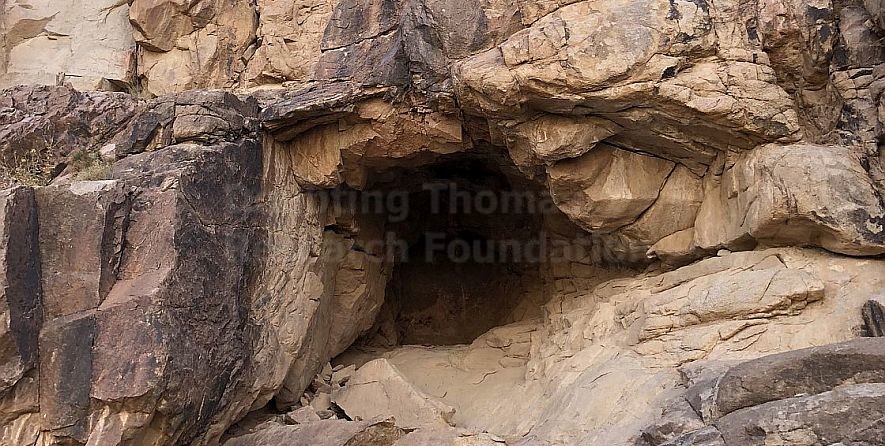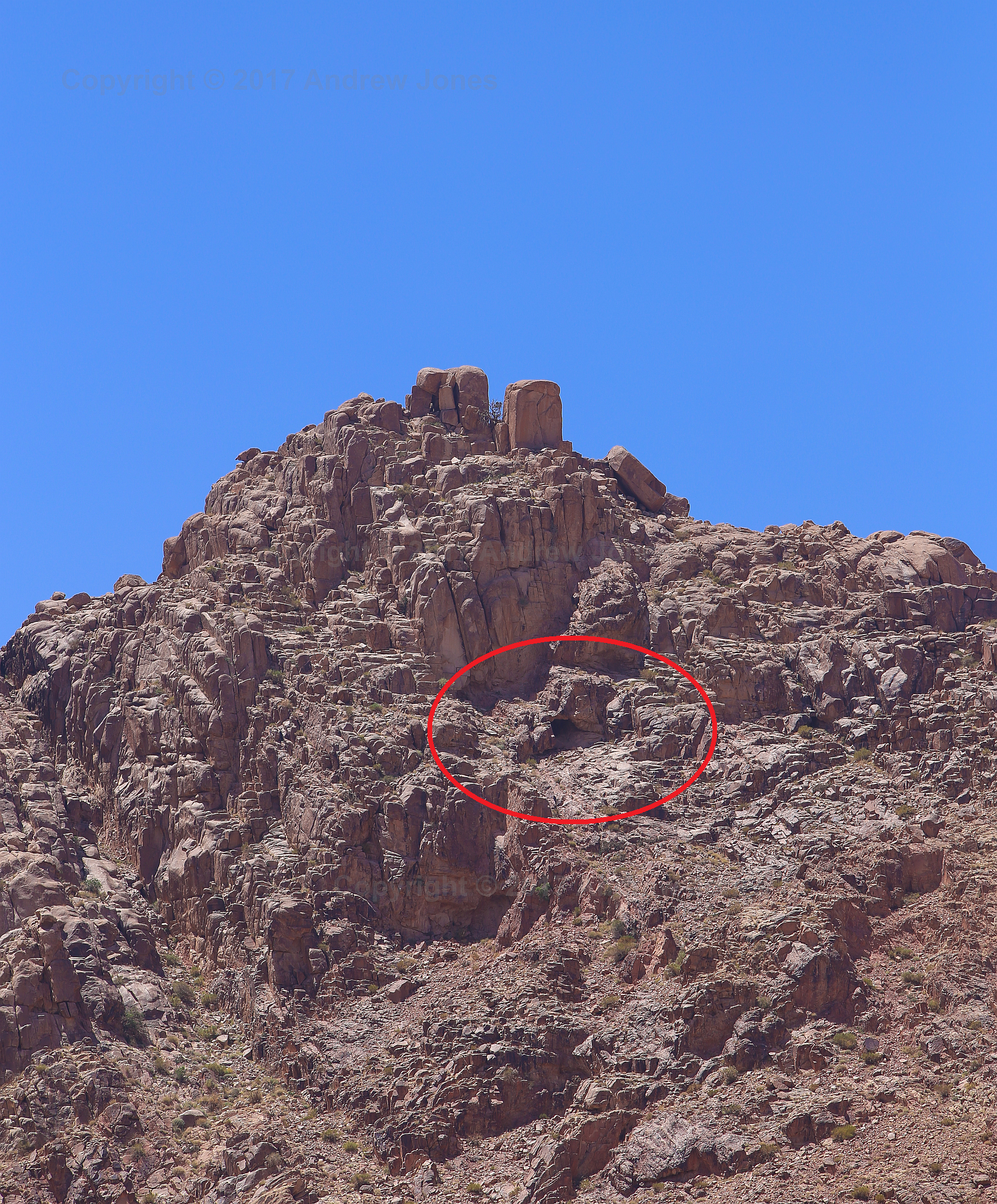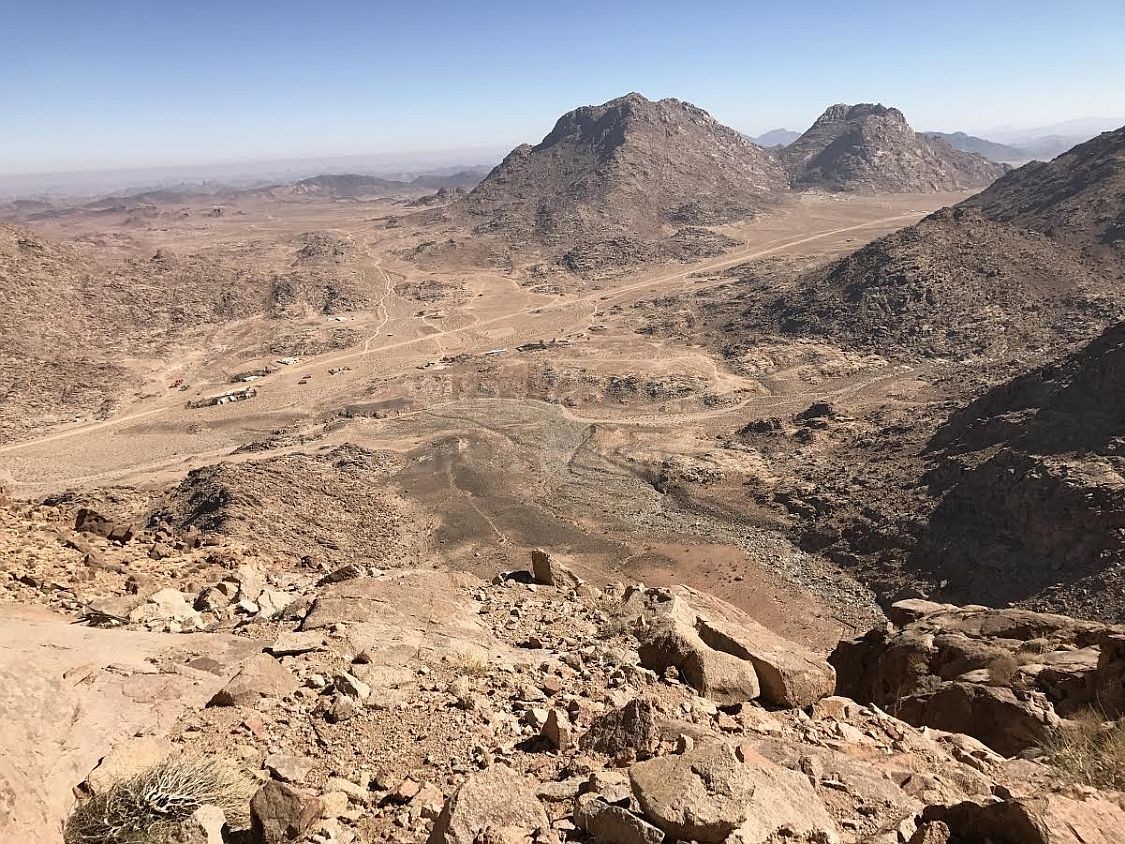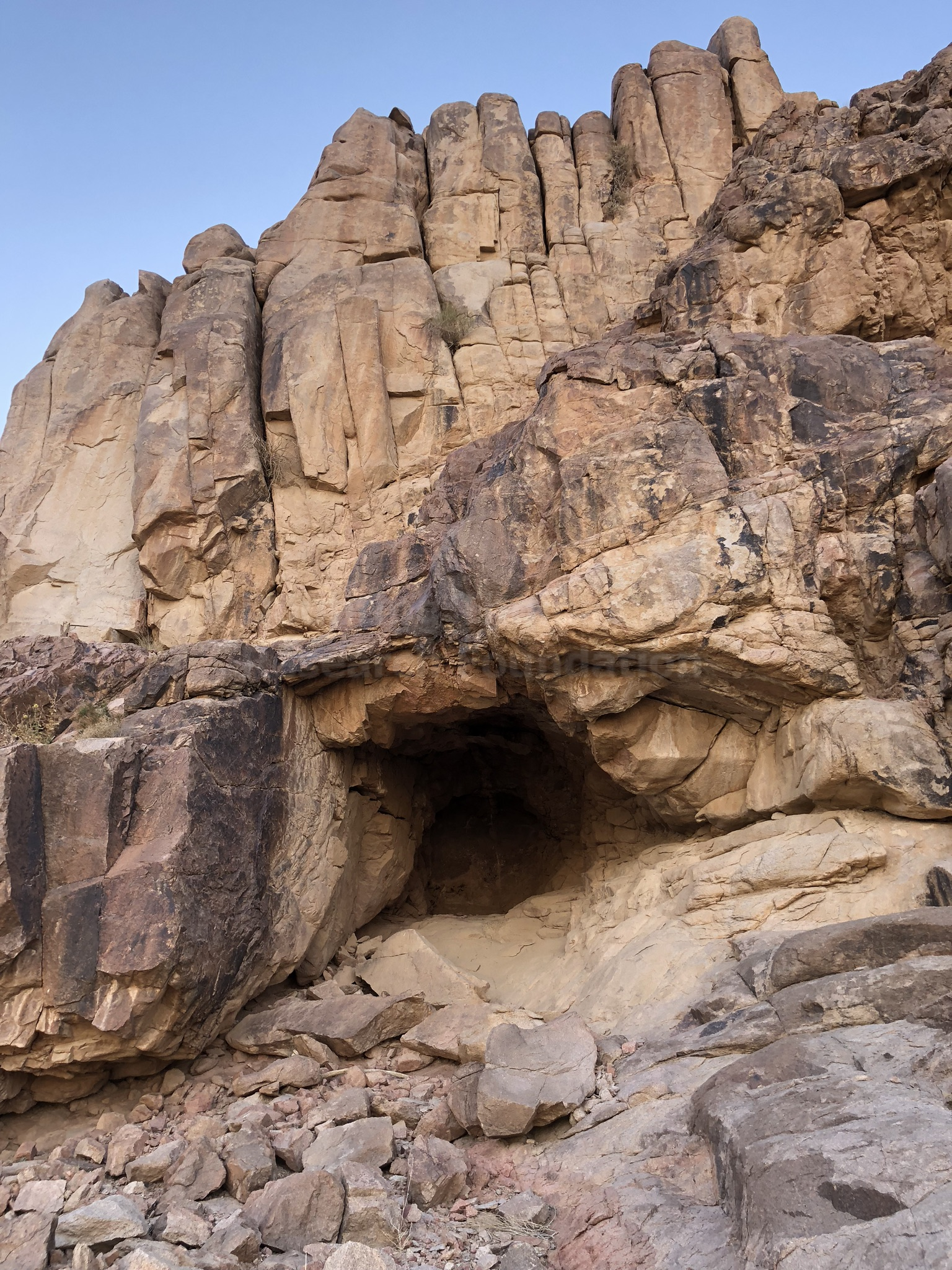The Cave of Elijah at Mount Sinai

According to 1 Kings chapter 19, the prophet Elijah stayed in a cave on Mount Horeb/Sinai and interacted with God there. He was fleeing Ahab and Jezebel in fear of his life.
Elijah traveled “a day’s journey into the wilderness” from Beersheba in Judea, which is believed to be the archaeological site of Tel Sheva in southern Israel. It is to the east of the Israeli city today named Beer Sheba.
From there, Elijah traveled 40 days and 40 nights to “Horeb, the mountain of God." Once he arrived, he found a cave to sleep in for the night.
The next day, God instructed Elijah to “go out and stand on the mountain in the presence of the Lord, for the Lord is about to pass by.”
There was then a tremendous wind that caused rocks to fall, an earthquake, and a fire. Elijah was protected as the Lord was not “in” the phenomenon. After the dangerous weather was over, Elijah heard a “gentle whisper” from God and then “pulled a cloak over his face and went out and stood at the mouth of the cave.”
Based on this record there must be a distinct and visible cave on Mount Sinai that would be noticeable upon a first visit. It must also be accessible.
The cave must be large enough to accommodate a person and deep enough for that person to sleep in out of view of predators. It should also be shaped so that Elijah could stand on the mouth of the cave or just in front of the mouth of the cave and converse with God.
The Cave of Elijah?
Although there are caves around the arena-like plain in front of Jabal Maqla, these are on the ground level. The Biblical account indicates that the cave was on the mountain itself.
There is only one cave that is very noticeable on the mountain from the ground level and reachable. It is located on the front of the mountain, above the possible altar of Moses and remnants of the 12 pillars.
The cave is about 15 feet high, 20 feet long and 20 feet deep. The top of the cave decreases from 15 feet to about 8 feet as one goes further into the back of the cave. It would be a safe, comfortable and easily discoverable cave for a single person to sleep in.
Early 20th-century theologian and explorer Alois Musil discussed Elijah's journey in his 1926 book The Northern Hegaz: A Topographical Itinerary. On his forty-day journey, the prophet traveled from Samaria to Beersheba, then proceeded southward.
Musil believed that Elijah traveled not to the Sinai Peninsula, but more directly south into ancient Midian.
The round figure of forty days and forty nights shows that he journeyed for a very long time. The statement that he proceeded from Beersheba southward proves that he traveled in the direction of Elath, or the modern al-'Akaba, and that he thus went to the land of Madian. After he had been strengthened by the Lord, he was to return through the wilderness to Damascus (1 Kings 19:15). He accordingly must have proceeded by caravan along the great transport route on the eastern frontiers of Edom and Moab northward, thus along the 'Araba road, which the migrating Israelites reached near Ma'an (Deut., 2:8).
These are the only Biblical records from which it is at all possible to determine the position of Horeb, the mountain of God.
Alois Musil, The Northern Hegaz: A Topographical Itinerary, (New York: American Geographical Society, 1926), 297.
Our team would dispute Musil's final statement that the account of Elijah traveling to Mount Sinai is the only Biblical record from which we can determine the mountain's true location.
There are many passages in Scripture that would indicate a location in/near Midian for Mount Sinai - such as when Moses encountered the Burning Bush and passages detailing the geography of the Red Sea crossing site (Yam Suph).
These details can be found in our other articles addressing these topics.
Nonetheless, we agree with Musil's overall assessment that the record in 1 Kings of Elijah's flight to Mount Sinai does, indeed, point to a location in the region of Midian - modern-day northwest Saudi Arabia.




I had long thought the Exodus was a marvelous story told for spiritual and moral lessons. Now I see that I was utterly wrong and I am so glad! I rejoice and am exceedingly glad! This has made my faith so much stronger. Oh, and I emailed President Trump and explained this matter to him and how these sites must not be destroyed in the construction of the city of Neom. I hope he reads it.
God bless you in this wonderful work and cause.
Dr. Nathaniel J. Merritt Met.D.
It’s quite surprising that only in recent times have people begun to look in Arabia for clues about the exodus. The bible itself says that God spoke to Moses in Midian
“19 Now the Lord had said to Moses in Midian, “Go back to Egypt, for all those who wanted to kill you are dead.” 20 So Moses took his wife and sons, put them on a donkey and started back to Egypt. And he took the staff of God in his hand.”
Exodus 4:19-20
Wow…that is a great poit!! Good job.
There is no cave – none – at the traditional site of Mt. Sinai on the Sinai Peninsula at St. Catherines. Very little, in fact, dovetails with the biblical narrative at St. Catherines.
Of course the cave is there, aren’t you seeing it? It seems that your evidence indicates that Mount Sinai is the site of Moses in the exodus, and the crossing of the Red Sea, I hope it is, it is extraordinary, you have done good research and exposed even your life, what a shame it gives me that Muslims want to erase from the face of the earth such important evidence for the Christian world and for them too, Moses and other greats of the Bible were born in Muslim lands (today) but so important in the Christian, Jewish faith and the history of the lifetime.
Isn’t the tree above the cave of Elijah the real burning bush? Take into consideration where that cave is located just bellow where Moses encounter God, and bellow in the valley is Moses altar. And God said, “I will be with you. And this will be the sign to you that it is I who have sent you: When you have brought the people out of Egypt, you will worship God on this mountain.”Exodus 33:22
22 and while my glory passes by I will put you in a cleft of the rock, and I will cover you with my hand until I have passed by;
The flaw in this theory is that it ignores Ex 4:27. Aaron meets Moses at the “Mountain of God” en route between Midian and Egypt. Har Karkom is the best candidate. You list it here as an alternate theory but you do not explain why you reject it; I recommend you look further into this.
Hello Alexander, Logan with the research team here. We appreciate your feedback! Thanks so much for writing in!
Not at all meaning this disrespectfully – but – we do not feel that Exodus 4:27 contradicts a Saudi Arabian location for Mount Sinai. There are many geographical descriptions in the Torah and elsewhere in the Tanakh that point to the Red Sea crossing having occurred at the Gulf of Aqaba. If this is the case, as we believe it is, Mount Sinai would then be located in what is today Saudi Arabia, in the vicinity of ancient Midian. Feel free to check out some of our other articles discussing this topic.
Additionally, if you haven’t, we highly recommend looking into the work of Dr. Glen Fritz for a very detailed/scholarly analysis of this information. His two books, “The Lost Sea of the Exodus” and “The Exodus Mysteries: Of Midian, Sinai, and Jabal al-Lawz” are great resources.
Or, you could check out this (FREE) interview Dr. Fritz did with Epic Archaeology:
https://youtu.be/FDsyw_UHKwk
Also, keep in mind, that a handful of verses before verse 27, in verse 19, the text states that “The LORD said to Moses IN MIDIAN, “Go return into Egypt; for all the men who sought your life are dead.” This places the Burning Bush incident within the region of Midian – which, again, would place Mount Sinai in that same area.
Another thing to keep in mind is Ancient Near Eastern writing style. This writing style typically gives an overview of a topic, then goes into specific details regarding certain parts of that topic, then goes back to more of an overview perspective. It essentially works the same as inserting a parenthetical statement into the midst of a text.
For more information on this we recommend looking into the work of Dr. Peter Gentry. While refuting the documentary hypothesis in some of his resources, he explains this Ancient Near Eastern writing style and it’s dynamics.
Here are some links to a podcast interview series he did if you’re at all interested:
https://kgov.com/rebutting-the-documentary-hypothesis-with-peter-gentry-and-umberto-cassuto
https://rsr.org/gentry-2
https://kgov.com/gentry-3
We feel that Exodus 4:27 is best explained by this writing style. This is further strengthened by all of the aforementioned geographical qualifiers surrounding the Red Sea crossing site, the location of which, again, is one of the major determining factors of where Mount Sinai is to be located.
Lastly, we reject Har Karkom as Mount Sinai (although we do find its archaeology intriguing) because it is within the boundaries of the Promised Land as laid out in Scripture. Aside from the spies that entered Canaan before the 40 years of wandering, the Israelites of the Exodus/Wandering era did not enter the Promised Land until they crossed the Jordan during the beginning of Joshua’s Conquest.
Therefore, Karkom cannot be Mount Sinai, otherwise the Israelites would have already been within the Promised Land when the Law was given, which is contrary to what Scripture states.
With all this being stated, we have great respect for those who hold to the Har Karkom position, even though we disagree with it. We have an ongoing dialogue with Deborah Hurn, one of Har Karkom’s big proponents, and have even begun developing a good friendship with her. We’re excited about her research and the thesis she is publishing detailing evidence she believes points to Karkom being Sinai. We hope one day to visit the site with her.
We think it’s a very good thing to have friendships and/or working relationships with people who advocate for different Mount Sinai candidates – if at all possible. Based on our research though and the research of scholars that we consider direct colleagues, we hold firm to Jabal al-Maqla being the authentic, Biblical mountain.